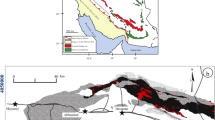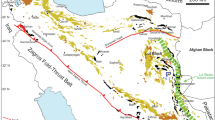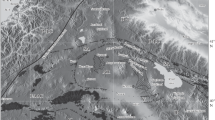Abstract
The high-K Tuzgle volcanic center, (24° S, 66.5° W) along with several small shoshonitic centers, developed along extensional Quaternary faults of the El Toro lineament on the east-central Puna plateau, ≈275 km east of the main front of the Andean Central Volcanic Zone (CVZ). These magmas formed by complex mixing processes in the mantle and thickened crust (>50 km) above a ∼200 km deep scismic zone. Tuzgle magmas are differentiated from shoshonitic series magmas by their more intraplate-like Ti group element characteristics, lower incompatible element concentrations, and lower 87Sr/86Sr ratios at a given εNd. Underlying Mio-Pliocene volcanic rocks erupted in a compressional stress regime and have back-arc like calc-alkaline chemical characteristics. The Tuzgle rocks can be divided into two sequences with different mantle precursors: a) an older, more voluminous rhyodacitic (ignimbrite) to mafic andestitic (56% to 71% SiO2) sequence with La/Yb ratios <30, and b) a younger andesitic sequence with La/Yb ratios >35. La/Yb ratios are controlled by the mafic components: low ratios result from larger mantle melt percentages than high ratios. Shoshonitic series lavas (52% to 62% SiO2) contain small percentage melts of more isotopically “enriched” arc-like mantle sources. Some young Tuzgle lavas have a shoshonitic-like component. Variable thermal conditions and complex stress system are required to produce the Tuzgle and shoshonitic series magmas in the same vicinity. These conditions are consistent with the underlying mantle being in transition from the thick mantle lithosphere which produced rare shoshonitic flows in the Altiplano to the thinner mantle lithosphere that produced back-are calc-alkaline and intraplate-type flows in the southern Puna. Substantial upper crustal type contamination in Tuzgle lavas is indicated by decreasing εNd (-2.5 to-6.7) with increasing 87Sr/86Sr (0.7063 to 0.7099) ratios and SiO2 concentrations, and by negative Eu anomalies (Eu/Eu* <0.78) in lavas that lack plagioclase phenocrysts. Trace element arguments indicate that the bulk contaminant was more silicic than the Tuzgle ignimbrite and left a residue with a high pressure mineralogy. Crustal shortening processes transported upper crustal contaminants to depths where melting occurred. These contaminants mixed with mafic magmas that were fractionating mafic phases at high pressure. Silicic melts formed at depth by these processes accumulated at a mid to upper crustal discontinuity (decollement). The Tuzgle ignimbrite erupted from this level when melting rates were highest. Subsequent lavas are mixtures of contaminated mafic magmas and ponded silicic melts. Feldspar and quartz phenocrysts in the lavas are phenocrysts from the ponded silicic magmas.
Similar content being viewed by others
References
Allmendinger RW, Strecker M, Eremchuk JE, Francis P (1989) Neotectonic deformation of the southern Puna plateau, NW Argentina. J S Am Earth Sci 2:111–130
Allmendinger RW, Figueroa D, Snyder D, Beer J, Mpodozis C, Isacks B (1990) Foreland shortening and crustal balancing in the Andes at 30° S latitude. Tectonics 9:789–809
Andersen DJ, Lindsley DH (1988) Internally consistent solution models for Fe−Mg−Mn−Ti oxides: Fe−Ti oxides. Am Mineral 73:714–726
Aquater (1980) Exploracion geotermica del árca del Cerro Tuzgle. Provincia de Jujuy, Republica Argentina. Secretaría de Estado de Minería, Argentina, open-file report.
Cahill T (1990) Earthquakes and tectonics of the central Andean subduction zone. PhD thesis, Cornell Univ, Ithaca, NY
Chinn D, Isacks BL, Barazangi M (1980) High frequency shear wave propagation along the western margin of South America: implications for oceanic Sn and the Altiplano. Geophys J R Astron Soc 60:209
Coira B, Barbieri M (1989) Relaciones isotópicas de estroncio de vulcanitas cenozoicas de los Andes centrales (22°–24° 30′ S) Puna, Argentina. Rev Asoc Geol Argen 44:89–95
Coira B, Kay SM (1991) Mantle and crustal components in high-K to shoshonitic series volcanic rocks in the eastern Argentine Puna. EOS Trans Am Geophys Union 72:295
Coira B, Knox WJ (1989) Cenozoic Andean volcanism in the Argentine Puna. Abstracts. 28th Int Geol Cong 1:310–311
Coira B, Paris G (1981) Estratigrafiá volcánica del área del Cerro Tuzgle (23° 50′ S y 66° 45′ W), Provínciás del Jujuy-Salta. VIII Cong Geol Argen III:659–671
Davidson JP, McMillan NJ, Moorbath S, Worner G, Harmon RS, Lopez-Escorbar L (1990) The Nevados de Payachata volcanic region (18° S/69° W.N. Chile) II. Evidence for widespread crustal involvement in Andean magmatism. Contrib Mineral Petrol 105:412–432
Deruelle B (1982) Petrology of the Plio-Quaternary volcanism of the south-central and meridional Andes. J Volcanol Geotherm Res 14:77–124
Deruelle B (1991) Petrology of Quaternary shoshonitic lavas of northwestern Argentina. In: Harmon RS, Papela C (eds) Andean Magmatism and its Tectonic Setting. Geol Soc Am Spec Paper 265:201–216.
De Silva SL (1989) Altiplano-Puna volcanic complex of the central Andes. Geology 17:1102–1106
Emerman S, Turcotte DL (1983) Stagnation flow with a temperature dependent viscosity. J Fluid Mech 127:507–517
Francis PW, Thorpe RS, Moorbath S, Kretschmar GA, Hammill M (1980) Strontium isotope evidence for crustal contamination of calc-alkaline volcanic rocks from Cerro Galan, north-west Argentina. Earth Planet Sci Lett 48:257–267
Francis PW, Sparks RSJ, Hawkcsworth CJ, Thorpe RS, Pyle DM, Tait SR, Mantovani MS, McDermott F (1989) Petrology and geochemistry of volcanic rocks of the Cerro Galan caldera, northwest Argentina. Geol Mag 126:515–547
Fuhrman ML, Lindsley DH (1988) Ternary-feldspar modeling and thermometry. Am Mineral 73:201–215
Grunder AL, Boden DR (1987) Comment on “... Magmatic conditions of the Fish Canyon Tuff, central San Juan volcanic field, Colorado” by Whitney and Stormer (1985). J Petrol 28:737–746
Gust DA, Perfit MR (1987) Phase relations of high-Mg basalt from the Aleutian Island Arc: Implications for primary island arc basalts and high-Al basalts. Contrib Mineral Petrol 97:7–18
Harmon RS, Barreiro BA, Moorbath S, Hoofs J, Francis PW, Thorpe RS, Deruelle B, McHugh J, Viglino JA (1984) Regional O-, Sr-, and Pb-isotope relationships in late Cenozoic calc-alkaline lavas of the Andean Cordillera. J Geol Soc London 141:803–822
Hildreth W, Moorbath S (1988) Crustal contributions to arc magmatism in the Andes of central Chile. Contrib Mineral Petrol 98:455–489
Hupport HE, Sparks RSJ (1988) The generation of granitic magmas by intrusion of basalt into continental crust. J Petrol 29:599–624
Isacks B (1988) Uplift of the central Andean plateau and bending of the Bolivian Orocline. J Geophys Res 93:3211–3231
Johnson CM (1991) Large-scale crust formation and lithosphere modification beneath Middle to Late Cenozoic calderas and volcanic fields, western North America. J Geophys Res 96:13485–13508
Johnson MC, Rutherford MJ (1989) Experimentally determined conditions in the Fish Canyon tuff, Colorado, magma chamber. J Petrol 30:711–737
Kay RW, Kay SM (1991) Creation and destruction of lower continental crust. Geol Rundsch 80:259–278
Kay S M (1991) Miocene “flat-slab” volcanic rocks as guides to lithospheric processes in the central Andes (28–33° S). XI Cong Geol Chileno 1:579–583
Kay S M, Maksaev V, Mpodozis C, Moscoso R, Nasi C (1987) Probing the evolving Andean lithosphere: middle to late Tertiary magmatic rocks in Chile over the modern zone of subhorizontal subduction (29–31.5° S). J Geophys Res 92:6173–6189
Kay S M, Viramonte J, Coira B (1990) Basalt to high-Mg andesite chemistry as guide to the mantle and the significance of a seismic gap in the Southern Argentine Puna of the central Andes. EOS Trans Am Geophys Union 71:1719
Knox WJ, Kay SM, Coira B (1989) Geochemical evidence for the origin of Quaternary basaltic andesite of the Puna, Northwestern Argentina. Rev Asoc Geol Argentina 64:194–206
Kussmaul S, Horman PK, Plosnonka E, Subieta T (1977) Volcanism and structure of southwestern Bolivia. J Volcanol Geotherm Res 2:73–111
Lefèvre C (1979) Un exemple de volcanisme de marge active dans les Andes du Pérou (sud) du Miocéne à l'Actuel. PhD thesis, University of Languedoc, France
Lindsley DH (1983) Pyroxene thermometry. Am Mineral 68:477–493
Marrett RA (1990) The late Cenozoic tectonic evolution and active mechanical state of the Puna plateau and adjacent foreland, northwestern Argentina Andes. PhD thesis, Cornell Univ, Ithaca, NY
Musselwhite DS, DePaolo DJ, McCurry M (1989) The evolution of a silicic magma system: isotopic and chemical evidence from the Woods Mountain Volcanic Center, eastern California. Contrib Mineral Petrol 101:19–29
Ort MH (1991) Eruptive dynamics and magmatic processes of Cerro Panizos. Central Andes. PhD thesis, Univ Calif Santa Barbara
Piccirillo DM, Melfi AJ (1988) The Mesozoic flood volcanism of the Parana Basin: petrogenetic and geophysical aspects. Universidad de Sao Paulo. Brazil, Instituto Astronomico e Geofisico, Sao Paulo
Pichler H, Ziel W (1972) The Cenozoic rhyolite-andesite association of the Chilean Andes. Bull Volcanol 35:424–452
Rapp RP, Watson EB, Miller CF (1991) Partial melting of amphibolite/eclogite and the origin of Archean trondhjemites and tonalites. Precambrian Res 51:1–25
Reagan MK, Gill JB (1989) Coexisting calc-alkaline and high niobium basalts from Turrialba Volcano Costa Rica: Implications for residual titanates in arc magma sources. J Geophys Res 94:4619–4633
Rogers G, Hawkesworth CJ (1989) A geochemical traverse across the North Chilean Andes: evidence for crust generation from the mantle wedge. Earth Planet Sci Lett 91:271–285
Schreiber U, Schwab K (1991) Geochemistry of Quaternary shoshonitic lavas related to the Calama-Olacapato-El Toro lineament (NW Argentina). J S Am Earth Sci 4:73–86
Schwab K (1972) Cenozoic volcanism in the Argentine Puna and its relationship to tectonic movements. 24th Int Geol Cong 2:211–221
Schwab K, Lippolt H (1974) K−Ar mineral ages and Late Cenozoic history of the Salar de Cauchari Area (Argentine Puna). In Gonzalez-Ferran O (ed) Proceedings of the Symposium of Andean and Antarctic volcanology problems, Santiago. Int Assoc Vol Geochem Earth Interior, Rome, pp 697–714
Stern C (1991) Role of subduction erosion in the generation of Andean magmas. Geology 19:78–81
Stormer JC Jr, Whitney JA (1984) Two feldspar- and iron-titanium oxide equilibria in silicic magmas and the depth of origin of large volume ash-flow tuffs. Am Mineral 70:52–64
Thorpe RS, Francis PW, O'Callaghan P (1984) Relative roles of source composition, fractional crystallization and crustal contamination in the petrogenesis of Andean volcanic rocks. Philos Trans R Soc London A 310:675–692
Viramonte JG, Galliski MA, Arana Saavedra VA, Aparicio A, Garcia Cacho L, Martin Excorza C (1984a) El finivolcanismo básico de la depresion de Arizaro-Provincia de Salta. IX Cong Geol Argentino III:234–254
Viramonte JG, Omarini RH, Arana Saayedra VA, Aparicio A, Garcia Cacho L, Parica P (1984b) Edad, genesis y mecanismos de erupción de las riólitas granatíferas de San Antonio de los Cobres, Provincia de Salta. IX Cong Geol Argentino III:216–233
Whitman D, Isacks BL, Chatelain J-L, Chiu J-M, Perez A (1992) Attenuation of high frequency seismic waves beneath the central Andes and uplift of the central Andean plateau. J Geophys Res (in press).
Whitney JA, Stormer JC (1985) Mineralogy, petrology and magmatic conditions from the Fish Canyon Tuff, Central San Juan volcanic field, Colorado. J Petrol 26:726–762
Author information
Authors and Affiliations
Rights and permissions
About this article
Cite this article
Coira, B., Kay, S.M. Implications of Quaternary volcanism at Cerro Tuzgle for crustal and mantle evolution of the Puna Plateau, Central Andes, Argentina. Contr. Mineral. and Petrol. 113, 40–58 (1993). https://doi.org/10.1007/BF00320830
Received:
Accepted:
Issue Date:
DOI: https://doi.org/10.1007/BF00320830




